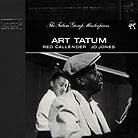September 2000
Jazz lovers are forever indebted to Norman Granz’s wise decision to record as much Art Tatum as possible before he passed away, much too early at the age of 47 in November, 1956. And while Tatum is best known for his solo performances, Granz wisely taped Tatum’s small-group outings with some of his greatest musical contemporaries -- such as Ben Webster, Roy Eldridge, Benny Carter, Lionel Hampton, Sweets Edison. On Group Masterpieces, Vol. 6, Tatum teams up with bassist Red Callender (a top-flight session player who, in the course of a distinguished career, turned down offers to join Duke Ellington and Louis Armstrong) and drummer Jo Jones (who played with the greatest of the Count Basie orchestras). Tatum was born nearly blind in 1909 and was mostly self taught. A pianist who mastered all the styles of his day (stride, swing, boogie-woogie) and fused them with innovations that mirrored more modern techniques, Tatum could play rapid lines with either (or both) hands and improvise at will at any speed. While some detractors claimed Tatum could only strut his stuff when playing solo (with a certain amount of justification, I might add), Granz sought to disprove that charge with his series of group sessions. This album allowed Tatum to clearly demonstrate his solo skills while still playing as part of a trio. Callender and Jones were capable of keeping up with Tatum, but also selfless enough to give him the space needed to develop any ideas that came to him during the recording session. "I’ll Never Be The Same" and "Blue Lou" readily illustrate this highly developed interplay -- and for a good idea as to Tatum’s ability to sublimate his tendency to run away with a song and play as part of an ensemble, check out "Trio Blues," which closes this disc. I dug out my Group Masterpieces, Vol. 6 LP (an original Verve Clef Series) and compared it with the XRCD2. I found the XRCD2 to be the better of the two, as it conveyed the music more clearly than did the LP. Tatum’s piano was easier to follow -- his technique more readily apparent -- on the CD. The same could be said, to a slightly lesser extent, of the bass and drums. However, since neither of those instruments were recorded as clearly as Tatum’s piano to begin with (keep in mind that this is a 1956 recording), there was only so much JVC could do to improve the sound. At times, listening to this disc, I found myself so caught up in Tatum’s awesome ability that I wasn’t even aware of the bass and drums. Upon a second audition, both instruments could be easily heard if I was paying attention to them. The CD also brought the players closer to my listening seat, removing some air from the recording venue, whereas the LP set them much further apart and deeper in the soundstage. This just may be the analog lover in me talking. Believe me, I’m ready and willing to listen to this or any other XRCD -- they all sound great. I should also point out that, since this is a mono recording, my references to imaging and soundstaging are relative terms. For comparisons sake, I pulled out my XRCD copy of Tatum playing with Ben Webster, given that these two discs were recorded at about the same time period, to see how far the XRCD2 process has improved the sound. I’m impressed! The XRCD2 displays more fullness, richness, and (dare I say it?) real-ness. I can’t wait to hear more of the new XRCD2s. JVC has taken their commitment to superior sound another step further without raising the cost (something that happens all too often in the audio community) -- and they should be applauded for it. As to whether you should plunk down your hard-earned cash for this disc, I feel that any music collection that doesn’t have at least one Art Tatum album in it is seriously deficient. And I can think of no better way of adding a great-sounding, as well as musically special, Art Tatum disc to your collection. Recommended. GO BACK TO: |
 Art Tatum - The Art Tatum Group Masterpieces, Vol. 6
Art Tatum - The Art Tatum Group Masterpieces, Vol. 6![[Reviewed on CD]](../format/regcd.gif) "If you asked ten pianists who the greatest jazz pianist who ever lived
was, eight would say Art Tatum, the other two are wrong." -- Tom Piazza, Guide To
Classic Jazz
"If you asked ten pianists who the greatest jazz pianist who ever lived
was, eight would say Art Tatum, the other two are wrong." -- Tom Piazza, Guide To
Classic Jazz